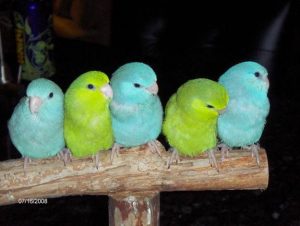
Today, we are going to look at starting a new eCommerce business selling Parrotlets online. We will start off looking at Parrotlets, so we understand the product, and then we will move onto general business principles, before looking at the eCommerce activities.
One of the best home business opportunities available today in the USA is to sell Parrotlets online using eCommerce techniques. In this article, you will see why it is such a wonderful business venture to be involved in.
By utilizing eCommerce you have a nationwide market for your Parrotlets. Linking your online store into an online payment provider, and a specialized shipping company allows you to operate a seamless online presence.
What are Parrotlets?
Parrotlets are the smallest member of the parrot family. They are smaller than budgies. You might suppose the closest relative of the Parrotlet would be the budgie, but strangely enough, the Amazon Parrot is its closest family member. They look very much like their much larger relative and have very similar traits. This is why the Parrotlet is sometimes called a “Pocket Parrot.”
Unlike many small birds, a Parrotlet that is well cared for can live up to 20 years in captivity. Some even survive into their 30s. Typically Parrotlets are feisty and sassy, with larger than life personalities. Parrotlet owners need to ensure that they handle the little birds every day and provide enough toys to keep them amused. Failure to pay enough attention will result in a destructive pet. Parrotlets also require a lot of exercises, which can sometimes be challenging. Parrotlets given time with their owners will learn to talk and/or perform tricks.
Care of Parrotlets
It is best to keep parrotlets as single pets. If kept in a pair, one will become dominant, possessive and will keep all the best toys to himself. Despite their size, parrotlets are brave little birds and will get into trouble if left outside their cage unsupervised. They are territorial and will attack other birds and even try to take on the family dog.
Diet
The Parrotlet diet is something akin to the Parakeet diet.
- · Pellets 25% to 45%
- · Low-fat seed mix 15% to 25% (millet, barley, grass seeds, etc)
- · Fresh vegetables 30% to 50%
Individual Housing
These active and smart birds require lots of toys and a cage at least 18” by 18”. Larger cages are ok as well, as long as they are not so large that the Parrotlet gets lost. The cages should also not have bars that are larger than �inch apart, or there is a risk it will get its head stuck.
The law regarding selling parrotlets
Birds are the largest group of captive wild animals in the United States. Generally speaking the regulations for keeping and selling birds are fewer than for other animals. In the United States, there may be both federal regulations and state regulations that you are required to follow when selling birds.
Federal laws
You do not require a federal license to keep or sell parrotlets. There is no specific mention of parrots in the Animal Welfare Act. They are also frequently excluded from animal welfare legislation, regulations on pet shops, and existing animal cruelty laws.
State laws
State laws can be quite varied. Here is a document that summarizes the State Laws regarding Birds in Pet Shops produced by the Born Free Foundation.
Zoning laws
Most cities have zoning laws that limit the number of dogs and cats that an individual can own. It is very rare for such laws to apply to birds. There are usually local ordinances that may state the maximum size of an outdoor aviary. Before you start a small business selling birds, you may be wise to check in with your local municipality to check with them, before you invest in the business. You also need to check with your condominium, sub-division, or townhome association to check if any regulations apply.
Selling Parrotlets as a business venture
Starting a bird business in your backyard can be a profitable venture. We will take a look at this venture in some detail. First of all, I want to look more generally at the business and then I will move onto the eCommerce aspects.
This venture can provide an excellent return whether you operate it as a part-time venture, or ramp it up into a full-time business.

Breeding
Breeding is an essential part of this business, as it is what provides your stock of birds. Let me first say that Parrotlets are not easy to breed, which is good, as it stops amateurs from breeding them without investing time and money in the process.
Your birds will need to be one year old, at least, before they will breed. During breeding, they do not need a large cage to fly around in. 14” x 14” x 14” breeding cages are fine. Each cage should have two perches that are sturdy and well fixed. Perches that seem insecure will result in infertile couples. The perches should be made from natural wood so that the birds can exercise their feet.
There should be one pair per cage. The problem with breeding parrotlets is that they are hugely territorial and just put two strange birds in together and they will fight (potentially killing each other). You need to take your time and introduce them to each other slowly. You need to increase the amount of fat and protein in the diet of the breeding pair. Place the female in the breeding cage a few days before the male.
Parrotlets breed significantly better if there are other breeding pairs in the aviary. They should be able to hear the other pairs, but not see them. Your new breeders are probably not going to succeed at first, and the new parents may not get the hang of being parents at first and neglect their offspring or not sitting on the eggs. They will learn, so be patient. Do not worry, after two or three clutches they will get the idea. In the optimum environment, they may produce between two and three clutches every year. So if you have several breeding pairs you will be building a good stock of birds. A clutch of eggs will typically be between 4 to 7 eggs, although they have been known to lay 10. They will lay one egg every other day until the clutch is complete. The usual incubation timescale is 18 to 19 days. Chicks are removed at 10 days of age but never leave more than four chicks there at a time, remove the oldest one when a new chick hatches. For detailed information about weaning and sexing Parrotlets Google the topic and there is ample material online.
Setting up the Breeding Cages
Each cage should have a nesting box hung on the outside of the cage facing so that when they look out of the box they are facing the back of the cage (put the box on the front of the cage). The nesting box should be 6” x 10” x 7” and filled with between 2” and 3” of unscented nesting material. Open design food and water dishes should be placed away from the perches, so they do not get droppings in them. Water should be placed in a glass tube fountain.
The breeding cages cab be stacked with partitions between them so the pairs cannot see each other. All of the breeding boxes will be on the front where you can easily access them.
Some Parrotlets take great delight in throwing all the bedding out of the nesting box onto the floor of the cage. You will need to keep an eye out for this and replace it immediately.
Sometimes when they have laid eggs the Parrotlets will lose an egg by burying it in the shavings. You need to do checks on each nesting box at least every two days to keep an eye on progress. This also has another purpose, it gets the birds used to you be around.
When removing the babies a useful tip is to use a piece of cardboard to hold the adult birds back. If they manage to bite your hand it will be extremely painful and they will not let go easily. The female will not usually leave the nesting box as much as the male. Be careful, if they feel threatened they will sometimes attack the babies.
OK, that has dealt with the breeding process. This ongoing process will keep a constant supply of new Parrotlets once you get going. You can encourage year-round breeding by using artificial full-spectrum lighting in the aviary which switches on at 8 am and off at 11 pm. The aviary is airconditioned and temperatures are never allowed to drop below 80b degrees.
When setting up your initial stock of Parrotlets, make sure that they are the same species. That way your growing stock will all be the same species and that makes them more valuable.
Finance
Prices for Parrotlets (normal not mutations) ranges between $100 and $300 each at retail price. With potentially 5 surviving chicks from a clutch, this can mean it is worth anything between $500 to $1500 per clutch, minus your expenses. With a large aviary with multiple breeding pairs, this can become quite an income, as long as you find the customers.
Now moving on to the Sales aspects and how to sell these chicks using eCommerce

What is required to sell Parrotlets online?
Looking at this business proposition there are several stages that you need to go through to start your business. This will take some time, but buying your initial stock of Parrotlets and building up a breeding stock is not going to be done overnight, so you have plenty of time.
(1) Find websites for people doing this already. Spend a lot of time looking at their website, what they are offering, and how they are offering their products, delivery, etc. Study every aspect of their business. I would even use the best website that you find and place an order for a Parrotlet with them, making sure it is of the species that you want to sell. You can then check out the whole eCommerce experience and see what their delivery service is like. Try and find reviews if you can. Identify ways that you could improve on what your competitors do.
(2) If you are selling Parrotlets online then you have to be breeding them yourself. If you buy your stock online and resell them, there is no way to make a profit. So, while building your website you have to be setting up the actual product business, the aviaries, and the equipment you will need. Your website will take time before it starts to generate customers so be patient. This is not a business you can start overnight.
(3) Now you have seen how your competitors sell online you can look at ways to make the whole process smoother, more user-friendly Choose an eCommerce platform that will be used to set up your website. I would suggest using WordPress for a platform and then installing WooCommerce. Build your store or employ someone to do it for you.
(4) Part of setting up your store is knowing how you are going to ship the birds. Shipping is a complex subject and we suggest that you refer to Airbourne Animals [RB1] for advice on shipping. They are a specialist in shipping birds and have a thorough understanding of the whole process.
(5) The shipping costs that you get from this company can then be built into the eCommerce software so that customers pay the cost of transport when they buy the bird.
(6) You will also need to set up payment options. You could use PayPal, or integrate a payment provider into WooCommerce. One supplier that integrates with WooCommerce is 2Checkout.
(7) The final component that you need on your website is a helpdesk that allows your customers, and potential customers to get answers to their questions.
(8) It is quite possible to set up a website yourself using WordPress, WooCommerce, and 2Checkout. However, hiring someone else is also a potential option.
Conclusion
An online store where people can buy a Parrotlet when linked to a breeding facility is an incredibly profitable concept. Take your time to set up the aviary and to build a breeding stock of birds, and while you wait for that to happen you can develop an online presence. It is not going to happen overnight, but this is something you can start to prepare today.